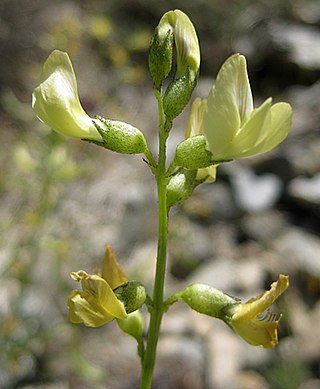
Astragalus agnicidus is a rare species of milkvetch known by the common name Humboldt County milkvetch. It is endemic to northern California, where it is known only from two populations in Humboldt County and one in Mendocino County.

Astragalus asymmetricus is a species of milkvetch known by the common name San Joaquin milkvetch. It is endemic to California, where it grows in grassy and disturbed areas in the Central Valley and nearby parts of the Central Coast Ranges and San Francisco Bay Area.

Astragalus casei is a species of milkvetch known by the common name Case's milkvetch. It is native to the Mojave Desert and its sky island woodlands of eastern California and western Nevada.
Astragalus cimae is a species of milkvetch known by the common name Cima milkvetch. It is native to the Mojave Desert and its sky island woodlands of eastern California western Nevada, especially on calcareous soils, including the Cima Dome area in the Mojave National Preserve.
Astragalus claranus is a rare species of milkvetch known by the common names Clara Hunt's milkvetch and Napa milkvetch. It is endemic to northern California where it is known from only four or five occurrences along the border between Sonoma and Napa Counties. It is a federally listed endangered species.

Astragalus deanei is a rare species of milkvetch known by the common name Dean's milkvetch, or Deane's milkvetch. It is endemic to southern San Diego County, California, where it grows on the slopes of the Peninsular Ranges between El Cajon and Tecate.

Astragalus didymocarpus is a species of milkvetch known by the common names Dwarf white milkvetch and Two-seeded milkvetch. It is native to the southwestern United States and northern Mexico, where it can be found in many types of habitat.

Astragalus filipes is a species of milkvetch known by the common name basalt milkvetch. It is native to western North America from British Columbia to California to Utah, where it grows in many types of habitat, especially dry areas.
Astragalus mohavensis is a species of milkvetch known by the common name Mojave milkvetch. It is native to the Mojave Desert of California and Nevada.
Astragalus monoensis is a rare species of milkvetch known by the common name Mono milkvetch. It is endemic to the open pumice plains of central Mono County, California.

Astragalus oocarpus is a rare species of milkvetch known by the common names San Diego milkvetch and Descanso milkvetch.

Astragalus oophorus is a species of milkvetch known by the common name egg milkvetch. It is native to the western United States, mainly California and Nevada, though one variety can be found as far east as Colorado. It is a plant of sagebrush and other dry habitat.
Astragalus pauperculus is an uncommon species of milkvetch known by the common name depauperate milkvetch. It is endemic to northern California, where it is known from the northern Sacramento Valley and the lowest reaches of the Cascade foothills adjacent. It grows in chaparral and vernally wet grassland habitat. This is a very small annual milkvetch which grows in a delicate mat with stems no longer than 10 cm (3.9 in). The leaves are a few centimeters long and are made up of small widely spaced leaflets. The inflorescence bears two to seven flowers which are purple, sometimes with paler colored edges on their petals. Each flower is generally less than 1 cm (0.39 in) long. The fruit is a crescent-shaped legume pod between 1 and 2 cm long.

Astragalus platytropis is a species of milkvetch known by the common name broadkeel milkvetch. It is native to the western United States from Montana to California, where it lives at high elevation in alpine and subalpine plant communities. This is a small perennial milkvetch which forms a small patch of short silvery-green stems on rocky ground. The leaves may be up to 9 cm (3.5 in) long and are made up of several hairy leaflets. The inflorescence is a head of four to nine pale purple flowers, each just under 1 cm (0.39 in) long. The fruit is a bladdery legume pod which can exceed 3 cm (1.2 in) long.

Astragalus pulsiferae is a species of milkvetch known by the common name Ames's milkvetch. It is native to California and Nevada, and it is known but rare in Washington. It is known from many habitat types, including mountains and plateaus.

Astragalus purshii is a species of milkvetch known by the common names woollypod milkvetch and Pursh's milkvetch.

Astragalus pycnostachyus is a species of milkvetch known by the common name marsh milkvetch. It is endemic to the coastline of California, where it grows in wet saline habitat such as marshes.

Astragalus rattanii is a species of milkvetch known by the common name Rattan's milkvetch. It is endemic to northern California, where it grows in the North Coast Ranges.

Astragalus tricarinatus is a rare species of milkvetch known by the common name triplerib milkvetch, or triple-ribbed milkvetch.

Astragalus webberi is a rare species of milkvetch known by the common name Webber's milkvetch. It is endemic to the coniferous forests in the Sierra Nevada, in Plumas County, eastern California.
















